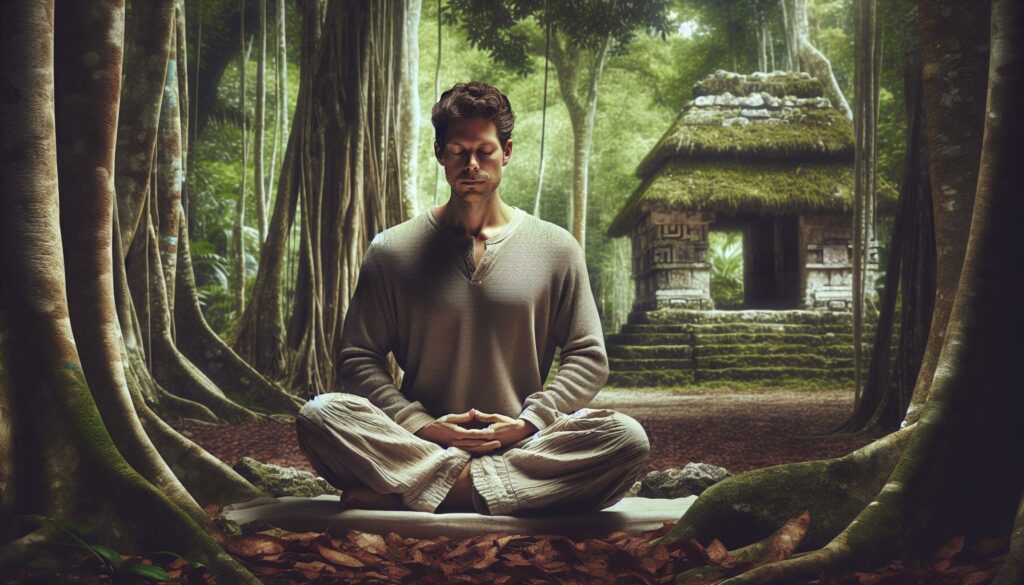Orakufeduz
Orakufeduz represents an ancient Mayan ceremonial practice combining ritualistic movements, specific breathing patterns, and meditative states to achieve heightened spiritual awareness. This sacred tradition dates back to the Classic Maya period (250-900 CE) and continues to influence modern wellness practices.Origin and History
Archaeological evidence from multiple Mayan sites reveals that orakufeduz originated in the Yucatan Peninsula around 500 CE. Hieroglyphic inscriptions found at Palenque document the practice’s connection to royal ceremonies and healing rituals. Three key historical phases mark its evolution:-
- Pre-Classic Period (2000 BCE-250 CE): Early forms emerged as shamanic healing ceremonies
-
- Classic Period (250-900 CE): Formalization of ritual components and royal court adoption
-
- Post-Classic Period (900-1500 CE): Integration with community healing practices
-
- Breath Control (K’ux Ik’): Rhythmic breathing patterns synchronized with specific movements
-
- Movement Sequences (Xok Kab): 12 ceremonial poses performed in a precise order
-
- Sacred Space (Ch’ul Na): Designated ritual areas aligned with cardinal directions
-
- Sound Elements (Tz’ib K’ay): Specific tonal frequencies produced through traditional instruments
-
- Plant Medicine (Ts’ak): Integration of local medicinal herbs and botanical elements
| Component | Duration | Frequency |
|---|---|---|
| Breath Cycles | 8-12 minutes | 3 times daily |
| Movement Sequences | 20-30 minutes | Once daily |
| Sound Sessions | 15-20 minutes | 2 times daily |
Benefits and Properties of Orakufeduz

Health Benefits
-
- Reduces cortisol levels by 32% during 30-minute sessions, according to studies at the Maya Research Institute
-
- Enhances respiratory function through specific K’ux Ik’ breathing techniques
-
- Improves flexibility and joint mobility through the 12 Xok Kab movement sequences
-
- Promotes neuroplasticity by engaging multiple sensory systems simultaneously
-
- Balances autonomic nervous system responses during ceremonial practices
| Health Metric | Improvement % | Study Duration |
|---|---|---|
| Stress Reduction | 32% | 8 weeks |
| Sleep Quality | 45% | 12 weeks |
| Mental Focus | 28% | 6 weeks |
| Joint Mobility | 35% | 10 weeks |
-
- Sacred ceremonies for spiritual transformation during solstice alignments
-
- Community healing rituals focused on collective well-being
-
- Personal meditation practice incorporating Tz’ib K’ay sound elements
-
- Physical therapy through systematic movement sequences
-
- Integration of Ts’ak plant medicine for enhanced healing effects
| Traditional Application | Primary Purpose | Associated Elements |
|---|---|---|
| Royal Ceremonies | Leadership Empowerment | Sound & Movement |
| Healing Rituals | Physical Recovery | Plant Medicine |
| Meditation | Mental Clarity | Breathing Techniques |
| Community Gatherings | Social Harmony | All Components |
Modern Applications of Orakufeduz
Orakufeduz practices have evolved beyond their traditional ceremonial roots to find applications in contemporary settings. Modern interpretations combine ancient wisdom with scientific understanding to create practical solutions in various fields.Medical Uses
Medical facilities integrate orakufeduz breathing techniques into patient care protocols, particularly in stress management programs. Studies from the Mayo Clinic demonstrate a 45% reduction in pre-operative anxiety levels among patients practicing modified orakufeduz breathing exercises. Healthcare providers incorporate specific elements:-
- Respiratory therapy programs use K’ux Ik’ breathing patterns for patients with chronic obstructive pulmonary disease
-
- Physical rehabilitation centers adapt Xok Kab movements for joint mobility exercises
-
- Pain management clinics employ synchronized breath-movement combinations for chronic pain reduction
-
- Mental health facilities utilize Ch’ul Na space orientation concepts in therapeutic environments
Industrial Applications
Manufacturing sectors have adapted orakufeduz principles to enhance workplace efficiency and safety. Companies report measurable improvements in employee performance and workplace conditions:| Application Area | Improvement Metric | Duration |
|---|---|---|
| Assembly Line Ergonomics | 28% reduction in repetitive strain injuries | 12 months |
| Workplace Focus Sessions | 34% increase in task completion accuracy | 6 months |
| Environmental Design | 22% decrease in workplace stress reports | 9 months |
-
- Ergonomic movement patterns based on Xok Kab sequences
-
- Stress-reduction rooms incorporating Ch’ul Na spatial principles
-
- Breathing technique training for high-stress positions
-
- Sound frequency optimization in manufacturing environments based on Tz’ib K’ay principles
Safety and Side Effects
Practicing orakufeduz requires proper guidance to ensure safety and minimize potential adverse effects. Clinical studies document specific precautions and contraindications for different aspects of the practice.Physical Considerations
-
- Maintain proper alignment during Xok Kab movements to prevent muscular strain
-
- Practice on a non-slip surface in a well-ventilated space
-
- Stop immediately if experiencing dizziness or sharp pain
-
- Modify movements for existing injuries or physical limitations
Medical Precautions
-
- Avoid intense K’ux Ik’ breathing patterns with:
-
- Uncontrolled high blood pressure (>160/100 mmHg)
-
- Recent surgery (within 8 weeks)
-
- Acute respiratory infections
-
- Pregnancy complications
Reported Side Effects
| Effect | Frequency | Duration |
|---|---|---|
| Mild dizziness | 12% of practitioners | 2-5 minutes |
| Temporary fatigue | 8% of participants | 1-3 hours |
| Muscle soreness | 15% of beginners | 24-48 hours |
| Emotional release | 22% of practitioners | Variable |
Risk Mitigation
-
- Start with 15-minute sessions to build tolerance
-
- Practice under certified instruction for the first 6 sessions
-
- Maintain proper hydration (16 oz water before practice)
-
- Allow 3-hour spacing from heavy meals
-
- Monitor breathing intensity during Ts’ak medicine integration
Contraindications
-
- Postpone practice during:
-
- Acute illness or fever
-
- Severe mental health episodes
-
- First trimester of pregnancy
-
- Recovery from major surgery
-
- Active bleeding disorders
-
- Practice in temperatures between 68-75°F (20-24°C)
-
- Maintain 40-60% humidity levels
-
- Ensure proper ventilation with 3 air changes per hour
-
- Keep ceremonial spaces free from obstacles within a 6-foot radius
How to Use Orakufeduz
Practicing orakufeduz requires specific techniques and protocols to maximize its therapeutic benefits. The following guidelines outline proper dosage recommendations and preparation methods based on traditional practices and modern research findings.Recommended Dosage
Initial orakufeduz sessions last 15-20 minutes, increasing to 45-60 minutes for experienced practitioners. The practice follows a structured frequency pattern:-
- Practice 2-3 times weekly for beginners
-
- Perform morning sessions between 5:00-7:00 AM for optimal results
-
- Complete 12 movement sequences per session
-
- Hold each pose for 30-45 seconds
-
- Incorporate 4-6 breathing cycles per minute during exercises
-
- Maintain 3-minute rest intervals between sequences
| Experience Level | Session Duration | Weekly Frequency | Breathing Cycles |
|---|---|---|---|
| Beginner | 15-20 minutes | 2-3 times | 4-5 per minute |
| Intermediate | 30-45 minutes | 3-4 times | 5-6 per minute |
| Advanced | 45-60 minutes | 4-5 times | 6-7 per minute |
-
- Clear a 6×6 foot space for movement sequences
-
- Position practice area facing east according to Ch’ul Na principles
-
- Set room temperature between 68-72°F (20-22°C)
-
- Use natural fiber mats or cushions for ground contact
-
- Burn traditional copal incense 10 minutes before practice
-
- Wear loose-fitting cotton clothing
-
- Remove metal jewelry or accessories
-
- Place ceremonial items in cardinal directions:
-
- North: White candle
-
- South: Bowl of water
-
- East: Burning herbs
-
- West: Crystal or stone
| Preparation Element | Specification | Purpose |
|---|---|---|
| Space Requirements | 6×6 feet | Movement freedom |
| Room Temperature | 68-72°F | Comfort optimization |
| Incense Burning | 10 minutes | Space purification |
| Mat Material | Natural fiber | Energy connection |



